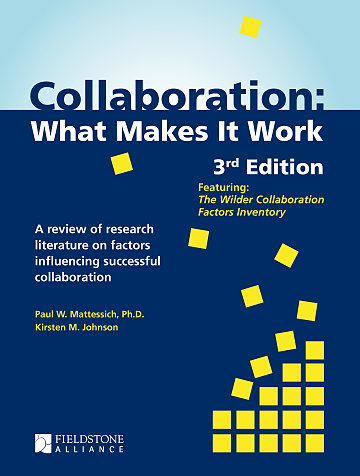
One of the better and more practical resources on community collaboration that I have utilized over the years is a little monograph published by the Wilder Foundation titled Collaboration: What Makes it Work (authors Paul W. Mattessich and Kirsten M. Johnson). I’ve long appreciated the practical advice, drawn from the research literature and from observed practice, and how well the authors conveyed that information concisely, in a 75 page handbook. So I was very pleased to see a new, third edition of the handbook was published last year, and I am happy to report that the new edition is even better. Here I highlight some of its key contributions, while offering my strong endorsement and recommendation for anyone doing boundary-crossing work to get your own copy of this resource.
Like the previous edition, the new third edition is focused on collaboration as “a mutually beneficial and well-defined relationship entered into by two or more organization to achieve common goals.” The book is organized around 22 collaboration success factors, grouped within six categories of
- Environment, which includes things like a history of working together and a favorable political and social climate;
- Membership Characteristics, such as the presence of mutual trust, an appropriate cross section of stakeholders, and ability to compromise;
- Process and Structure, which speaks to having different “layers of participation,” flexibility, and clear roles;
- Communication, including informal channels of communication;
- Purpose, meaning a true shared vision and concrete goals; and
- Resources, including funding and leadership.
The research literature that backs up these success factors has been updated, though a weakness that persists is the large volume of research on collaborative governance and collaborative processes from the field of public administration that is not included. Key scholars such as Russ Linden, Kirk Emerson, Tina Nabatchi, Chris Ansell, and Alison Gash, are not found in the bibliography, and while one of Barbara Crosby and John Bryson’s works is cited, there are several other highly relevant sources of theirs that are not. That is not to say the 22 success factors in this guide are contradicted by any of that missing literature. No, including key literature from public administration would bolster what the authors have done here. But there may be some missing or underdeveloped factors that the missing literature could speak to. For example, there is some good research on collaborative structures and governance that might give more depth to the “process and structure” dimension the authors describe. My recommendation for the next edition would be to engage that literature more and the result may be a refining of some factors and possibly creation of new ones.
That is my only real criticism of this new edition of Collaboration: What Makes It Work. This is still a fantastic resource, and one that is practice-oriented and should be used by public and nonprofit leaders working through partnerships and collaborative structures, which is very much the norm in communities and regions throughout the U.S., particularly with the practice of community and economic development.
One helpful element of this newest edition is an updated inventory of the collaboration success factors (that can be downloaded for free on the Wilder Foundation website). This is a wonderful tool can be used with collaborative groups to identify strengths and weaknesses and where extra effort may be needed. The updated website even offers groups to register so that group members can answer the questions anonymously, then the group as a whole can view summaries of responses. This opportunity to step back, as a collaborative group, and think about where they are at in terms of success factors, is a great resource that too few groups utilize. And this tool, offered as an ancillary to the new edition of the book, is a great way to do that kind of evaluation.
Other helpful updates in the new edition include discussion of collective impact (how that framework includes collaboration, but noting—importantly—that not all collaboration is collective impact). Discussion of how to put the factors to work has been significant expanded. And a new chapter was added on “collaborating across difference”—meaning navigating cultural differences, power dynamics and otherwise encourage thinking about more inclusive community collaboration. Finally, I really liked the addition of reflection questions (for individuals and groups) for each of the 22 success factors, added to this edition as a new appendix.
I highly recommend this practical, well-written resource (and, especially, the inventory tool that goes along with it) to anyone working across boundaries (collaborating across organizations, and often across sectors) in a community or regional context. You can find out how to get a copy of the book at the publisher’s page at https://www.turnerpublishing.com/books/detail/collaboration-3rd-edition/
This review is cross-posted on the Community and Economic Development In N.C. and Beyond blog